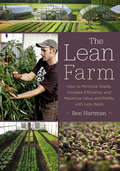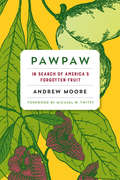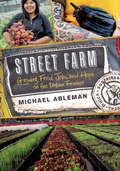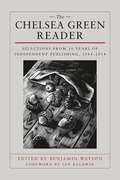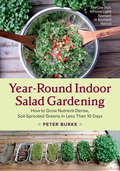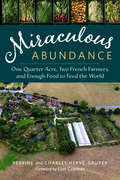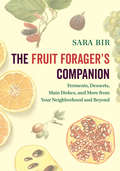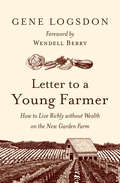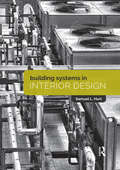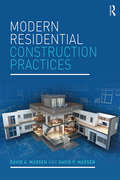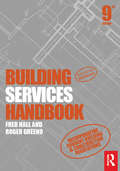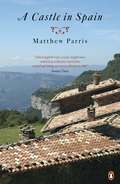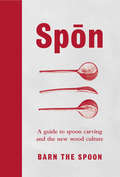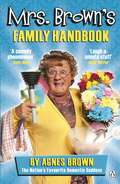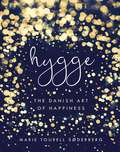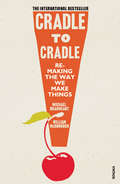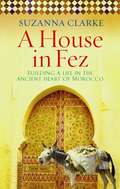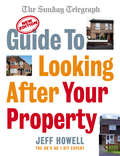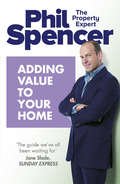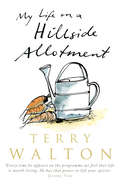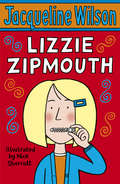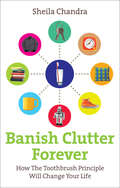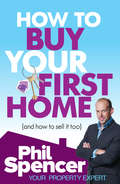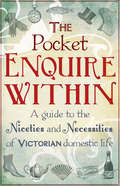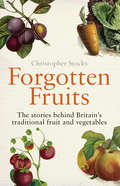- Table View
- List View
The Lean Farm: How to Minimize Waste, Increase Efficiency, and Maximize Value and Profits with Less Work
by Ben HartmanA practical, systems-based approach for a more sustainable farming operation To many people today, using the words “factory” and “farm” in the same sentence is nothing short of sacrilege. In many cases, though, the same sound business practices apply whether you are producing cars or carrots. Author Ben Hartman and other young farmers are increasingly finding that incorporating the best new ideas from business into their farming can drastically cut their wastes and increase their profits, making their farms more environmentally and economically sustainable. By explaining the lean system for identifying and eliminating waste and introducing efficiency in every aspect of the farm operation, The Lean Farm makes the case that small-scale farming can be an attractive career option for young people who are interested in growing food for their community. Working smarter, not harder, also prevents the kind of burnout that start-up farmers often encounter in the face of long, hard, backbreaking labor. Lean principles grew out of the Japanese automotive industry, but they are now being followed on progressive farms around the world. Using examples from his own family’s one-acre community-supported farm in Indiana, Hartman clearly instructs other small farmers in how to incorporate lean practices in each step of their production chain, from starting a farm and harvesting crops to training employees and selling goods. While the intended audience for this book is small-scale farmers who are part of the growing local food movement, Hartman’s prescriptions for high-value, low-cost production apply to farms and businesses of almost any size or scale that hope to harness the power of lean in their production processes.
Pawpaw: In Search of America’s Forgotten Fruit
by Andrew Moore Michael W. TwittyThe largest edible fruit native to the United States tastes like a cross between a banana and a mango. It grows wild in twenty-six states, gracing Eastern forests each fall with sweet-smelling, tropical-flavored abundance. Historically, it fed and sustained Native Americans and European explorers, presidents, and enslaved African Americans, inspiring folk songs, poetry, and scores of place names from Georgia to Illinois. Its trees are an organic grower’s dream, requiring no pesticides or herbicides to thrive, and containing compounds that are among the most potent anticancer agents yet discovered. So why have so few people heard of the pawpaw, much less tasted one? In Pawpaw—a 2016 James Beard Foundation Award nominee in the Writing & Literature category—author Andrew Moore explores the past, present, and future of this unique fruit, traveling from the Ozarks to Monticello; canoeing the lower Mississippi in search of wild fruit; drinking pawpaw beer in Durham, North Carolina; tracking down lost cultivars in Appalachian hollers; and helping out during harvest season in a Maryland orchard. Along the way, he gathers pawpaw lore and knowledge not only from the plant breeders and horticulturists working to bring pawpaws into the mainstream (including Neal Peterson, known in pawpaw circles as the fruit’s own “Johnny Pawpawseed”), but also regular folks who remember eating them in the woods as kids, but haven’t had one in over fifty years. As much as Pawpaw is a compendium of pawpaw knowledge, it also plumbs deeper questions about American foodways—how economic, biologic, and cultural forces combine, leading us to eat what we eat, and sometimes to ignore the incredible, delicious food growing all around us. If you haven’t yet eaten a pawpaw, this book won’t let you rest until you do.
Street Farm: Growing Food, Jobs, and Hope on the Urban Frontier
by Michael AblemanStreet Farm is the inspirational account of residents in the notorious Low Track in Vancouver, British Columbia—one of the worst urban slums in North America—who joined together to create an urban farm as a means of addressing the chronic problems in their neighborhood. It is a story of recovery, of land and food, of people, and of the power of farming and nourishing others as a way to heal our world and ourselves. During the past seven years, Sole Food Street Farms—now North America’s largest urban farm project—has transformed acres of vacant and contaminated urban land into street farms that grow artisan-quality fruits and vegetables. By providing jobs, agricultural training, and inclusion in a community of farmers and food lovers, the Sole Food project has empowered dozens of individuals with limited resources who are managing addiction and chronic mental health problems. Sole Food’s mission is to encourage small farms in every urban neighborhood so that good food can be accessible to all, and to do so in a manner that allows everyone to participate in the process. In Street Farm, author-photographer-farmer Michael Ableman chronicles the challenges, growth, and success of this groundbreaking project and presents compelling portraits of the neighborhood residents-turned-farmers whose lives have been touched by it. Throughout, he also weaves his philosophy and insights about food and farming, as well as the fundamentals that are the underpinnings of success for both rural farms and urban farms. Street Farm will inspire individuals and communities everywhere by providing a clear vision for combining innovative farming methods with concrete social goals, all of which aim to create healthier and more resilient communities.
The Chelsea Green Reader: Selections from 30 Years of Independent Publishing, 1984-2014
by Ben Watson Ian BaldwinChelsea Green, the Vermont-based independent publisher, has always had a nose for authors and subjects that are way ahead of the cultural curve, as is evident in this new anthology celebrating the company’s first thirty years in publishing. The more than one hundred books represented in this collection reflect the many distinct areas in which we have published–from literature and memoirs to progressive politics, to highly practical books on green building, organic gardening and farming, food and health, and related subjects–all of which reflect our underlying philosophy: "The politics and practice of sustainable living." The Chelsea Green Reader offers a glimpse into our wide-ranging list of books and authors and to the important ideas that they express. Interesting and worth reading in their own right, the individual passages when taken as a whole trace the evolution of a highly successful small publisher–something that is almost an oxymoron in these days of corporate buyouts and multinational book groups. From the beginning, Chelsea Green's books were nationally recognized, garnering positive reviews, accolades, and awards. We’ve published four New York Times bestsellers, and our books have set the standard for in-depth, how-to books that remain relevant years–often decades–beyond their original publication date. "Chelsea Green was born from a single seed: the beauty of craft. Craft in writing and editing, in a story well told, or a thesis superbly expressed," writes cofounder and publisher emeritus Ian Baldwin in the book's foreword. Today, craft continues to inform all aspects of our work–design, illustration, production, sales, promotion, and beyond. It has even informed our business model: In 2012, Chelsea Green became an employee-owned company. With the rise of the Internet, new media platforms, and a constantly shifting bookselling landscape, the future of publishing is anything but predictable. But if Chelsea Green's books prove anything, it is that, despite these challenges, there remains a hunger for new and important ideas and authors, and for the permanence and craftsmanship of the printed word. Today our ongoing mission is stronger than ever, as we launch into our next thirty years of publishing excellence.
Year-Round Indoor Salad Gardening: How to Grow Nutrient-Dense, Soil-Sprouted Greens in Less Than 10 days
by Peter BurkeThe Low-Tech, No-Grow-Lights Approach to Abundant Harvest Year-Round Indoor Salad Gardening offers good news: with nothing more than a cupboard and a windowsill, you can grow all the fresh salad greens you need for the winter months (or throughout the entire year) with no lights, no pumps, and no greenhouse. Longtime gardener Peter Burke was tired of the growing season ending with the first frost, but due to his busy work schedule and family life, didn’t have the time or interest in high-input grow lights or greenhouses. Most techniques for growing what are commonly referred to as “microgreens” left him feeling overwhelmed and uninterested. There had to be a simpler way to grow greens for his family indoors. After some research and diligent experimenting, Burke discovered he was right—there was a way! And it was even easier than he ever could have hoped, and the greens more nutrient packed. He didn’t even need a south-facing window, and he already had most of the needed supplies just sitting in his pantry. The result: healthy, homegrown salad greens at a fraction of the cost of buying them at the market. The secret: start them in the dark. Growing “Soil Sprouts”—Burke’s own descriptive term for sprouted seeds grown in soil as opposed to in jars—employs a method that encourages a long stem without expansive roots, and provides delicious salad greens in just seven to ten days, way earlier than any other method, with much less work. Indeed, of all the ways to grow immature greens, this is the easiest and most productive technique. Forget about grow lights and heat lamps! This book is a revolutionary and inviting guide for both first-time and experienced gardeners in rural or urban environments. All you need is a windowsill or two. In fact, Burke has grown up to six pounds of greens per day using just the windowsills in his kitchen! Year-Round Indoor Salad Gardening offers detailed step-by-step instructions to mastering this method (hint: it’s impossible not to succeed, it’s so easy!), tools and accessories to have on hand, seeds and greens varieties, soil and compost, trays and planters, shelving, harvest and storage, recipes, scaling up to serve local markets, and much more.
Miraculous Abundance: One Quarter Acre, Two French Farmers, and Enough Food to Feed the World
by Perrine Hervé-Gruyer Charles Hervé-Gruyer Eliot ColemanThe Bec Hellouin model for growing food, sequestering carbon, creating jobs, and increasing biodiversity without using fossil fuels When Charles and Perrine Hervé-Gruyer set out to create their farm in an historic Normandy village, they had no idea just how much their lives would change. Neither one had ever farmed before. Charles had been circumnavigating the globe by sail, operating a floating school that taught students about ecology and indigenous cultures. Perrine had been an international lawyer in Japan. Each had returned to France to start a new life. Eventually, Perrine joined Charles in Normandy, and Le Ferme du Bec Hellouin was born. Bec Hellouin has since become a celebrated model of innovative, ecological agriculture in Europe, connected to national and international organizations addressing food security, heralded by celebrity chefs as well as the Slow Food movement, and featured in the inspiring César and COLCOA award-winning documentary film, Demain ("Tomorrow"). Miraculous Abundance is the eloquent tale of the couple’s evolution from creating a farm to sustain their family to delving into an experiment in how to grow the most food possible, in the most ecological way possible, and create a farm model that can carry us into a post-carbon future—when oil is no longer moving goods and services, energy is scarcer, and localization is a must. Today, the farm produces a variety of vegetables using a mix of permaculture, bio-intensive, four-season, and natural farming techniques--as well as techniques gleaned from native cultures around the world. It has some animals for eggs and milk, horses for farming, a welcome center, a farm store, a permaculture school, a bread oven for artisan breads, greenhouses, a cidery, and a forge. It has also become the site of research focusing on how small organic farms like theirs might confront Europe’s (and the world’s) projected food crisis. But in this honest and engaging account of the trials and joys of their uncompromising effort, readers meet two people who are farming the future as much as they are farming their land. They envision farms like theirs someday being the hub for a host of other businesses that can drive rural communities—from bread makers and grain millers to animal care givers and other tradespeople. Market farmers and home gardeners alike will find much in these pages, but so will those who’ve never picked up a hoe. The couple’s account of their quest to design an almost Edenlike farm, hone their practices, and find new ways to feed the world is an inspiring tale. It is also a love letter to a future in which people increasingly live in rural communities that rely on traditional skills, locally created and purveyed goods and services, renewable energy, and greater local governance, but are also connected to the larger world.
The Fruit Forager's Companion: Ferments, Desserts, Main Dishes, and More from Your Neighborhood and Beyond
by Sara BirFrom apples and oranges to pawpaws and persimmons Half of the fruit that grows in yards and public spaces is never picked or eaten. Citrus trees are burdened with misshapen lemons, berries grow in tangled thickets on the roadside, and the crooked rows of abandoned orchards fill with fallen apples. At the same time, people yearn for an emotional connection that’s lacking in bland grocery store bananas and tasteless melons. The Fruit Forager’s Companion is a how-to guide with nearly 100 recipes devoted to the secret, sweet bounty just outside our front doors and ripe for the taking, from familiar apples and oranges to lesser-known pawpaws and mayhaws. Sara Bir—a seasoned chef, gardener, and forager—primes readers on foraging basics, demonstrates gathering and preservation techniques, and presents a suite of recipes including habanero crabapple jelly, lime pickle, pawpaw lemon curd, and fermented cranberry relish. Bir encourages readers to reconnect with nature and believes once the foraging mindset takes control, a new culinary world hiding in plain sight will reveal itself. Written in a witty and welcoming style, The Fruit Forager’s Companion is a must-have for seekers of both flavor and fun.
Letter to a Young Farmer: How to Live Richly without Wealth on the New Garden Farm
by Gene Logsdon Wendell BerryFor more than four decades, the self-described “contrary farmer” and writer Gene Logsdon has commented on the state of American agriculture. In Letter to a Young Farmer, his final book of essays, Logsdon addresses the next generation—young people who are moving back to the land to enjoy a better way of life as small-scale “garden farmers.” It’s a lifestyle that isn’t defined by accumulating wealth or by the “get big or get out” agribusiness mindset. Instead, it’s one that recognizes the beauty of nature, cherishes the land, respects our fellow creatures, and values rural traditions. It’s one that also looks forward and embraces “right technologies,” including new and innovative ways of working smarter, not harder, and avoiding premature burnout. Completed only a few weeks before the author’s death, Letter to a Young Farmer is a remarkable testament to the life and wisdom of one of the greatest rural philosophers and writers of our time. Gene’s earthy wit and sometimes irreverent humor combines with his valuable perspectives on many wide-ranging subjects—everything from how to show a ram who’s boss to enjoying the almost churchlike calmness of a well-built livestock barn. Reading this book is like sitting down on the porch with a neighbor who has learned the ways of farming through years of long observation and practice. Someone, in short, who has “seen it all” and has much to say, and much to teach us, if we only take the time to listen and learn. And Gene Logsdon was the best kind of teacher: equal parts storyteller, idealist, and rabble-rouser. His vision of a nation filled with garden farmers, based in cities, towns, and countrysides, will resonate with many people, both young and old, who long to create a more sustainable, meaningful life for themselves and a better world for all of us.
Building Systems in Interior Design
by Sam HurtBuilding Systems in Interior Design takes an entirely new approach to teaching this essential topic for Architects, Designers and Building Engineers. Written to prepare students for the real world and packed with practical examples, the book will foster an understanding of specific issues that are critical to those features of technical systems that most directly affect design. The book stresses the ever-present nature of these systems: they are everywhere, all the time. Taking a design oriented view, it outlines what can and cannot be done, and provides the student with the know-how and confidence to defend and promote their design intent when working with other industry professionals. Covering lighting, HVAC, plumbing and much more, the book is packed with key features to aid learning including: Numerous illustrations, plans and photographs Key terms defined in an extensive glossary Chapter introductions that identify key concepts and chapter summaries to re-visit those key concepts Professional design tips And a detailed bibliography and web links This book is not only a core text for interior design, building systems engineering and architecture students but will become an essential working reference through their careers.
Modern Residential Construction Practices
by David A. Madsen David P. MadsenModern Residential Construction Practices provides easy-to-read, comprehensive and highly illustrated coverage of residential building construction practices that conform to industry standards in the United States and Canada. Each chapter provides complete descriptions, real-world practices, realistic examples, three-dimensional (3D) illustrations, and related tests and problems. Chapters cover practices related to every construction phase including: planning, funding, permitting, codes, inspections, site planning, excavation, foundations and flatwork, floors, walls, roofs, finish work and cabinetry; heating, ventilating, and air conditioning (HVAC); electrical, and plumbing. The book is organized in a format that is consistent with the process used to take residential construction projects from preliminary concept through all phases of residential building construction. An ideal textbook for secondary and college level construction programs, the book is packed with useful features such as problems that challenge students to identify materials and practices, along with research and document information about construction materials and practices, useful summaries, key notes, a detailed glossary, and online materials for both students and educators.
Building Services Handbook
by Fred Hall Roger GreenoThe ninth edition of Hall and Greeno's leading textbook has been reviewed and updated in relation to the latest building and water regulations, new technology, and new legislation. For this edition, new updates includes: the reappraisal of CO2 emissions targets, updates to sections on ventilation, fuel, A/C, refrigeration, water supply, electricity and power supply, sprinkler systems, and much more. Building Services Handbook summarises the application of all common elements of building services practice, technique and procedure, to provide an essential information resource for students as well as practitioners working in building services, building management and the facilities administration and maintenance sectors of the construction industry. Information is presented in the highly illustrated and accessible style of the best-selling companion title Building Construction Handbook. THE comprehensive reference for all construction and building services students, Building Services Handbook is ideal for a wide range of courses including NVQ and BTEC National through Higher National Certificate and Diploma to Foundation and three-year Degree level. The clear illustrations and complementary references to industry Standards combine essential guidance with a resource base for further reading and development of specific topics.
A Castle in Spain
by Matthew Parris'Stands apart... This Englishman's castle might have started as a dream, but it has ended up being an extraordinary reality' Sunday TimesWalking in the Pyrenees one spring morning Matthew Parris stumbled upon a magnificent ruined mansion standing on the edge of a line of huge cliffs. Later he was to discover that parts of the house dated back to the 14th century though it had not been completed until 1559; and that it had survived two massive earthquakes before falling into disrepair in the early 1960s. A few years later, seduced by 'one of those foolish challenges that grip us in middle life', Parris bought the house, L'Avenc, and set about restoring it to its full glory. This delightful book chronicles it all: the original discovery, the attempts to discover its history, and then the long effortful years trying to bring it back to life in the face of scepticism from family, friends and Spanish neighbours. The original edition of A Castle in Spain was published in 2005 when the renovations were a work in progress; this new edition triumphantly records all that has happened since.
Spon: A Guide to Spoon Carving and the New Wood Culture
by Barn The Spoon'No one in Britain knows more about crafting a spoon from greenwood than Barn The Spoon.' Guardian'London's most famous and charismatic spoon whittler ... King of the whittlers.' Sunday Telegraph Barn The Spoon, as he’s affectionately known is a rare master craftsman in the art of spoon carving. In this book he generously shares his extraordinary skill, gentle philosophy and his life’s work – designing and carving beautiful spoons that are both a joy to use and hold.The simple, ordinary spoon is part of our everyday lives, intimately entwined with the acts of eating and socialising, from stirring our first cup of coffee to scraping the last bit of pudding from the bowl. And who doesn't like to spoon in bed? Barn’s spoons will take you on a journey into the new wood culture, from understanding the relationship between wood, the raw material and its majestic origins in our trees and woodland, to the workshop and the axe block, and into your own kitchen. Barn will show you how to use the axe and knife, from how they should feel in your hand to honing the perfect edge when carving your own spoons. Featuring sixteen unique designs in the four main categories of spoon – eating, serving, cooking and measuring spoons, Barn takes you through the nuances of their making, how each design is informed by its function at the table or in the kitchen, and the key skills you will learn – such as creating octagonal handles, manipulating grain patterns and mastering bent branches. Beautiful photography will inspire and act as a blue-print to help perfect your technique.
Mrs Brown's Family Handbook
by Brendan O'CarrollThe first and only official Mrs Brown's Boys book, Mrs Brown's Family Handbook uniquely takes us into the wonderful world of Britain's favourite potty-mouthed mother and housewife.Packed with tips for running the perfect home - why every mammy's secret weapon is a tea towel; how to clean up Granddad - as well as contributions from members of the extended family - Dermot's Guide to Farting; Winnie's Joy of Seks - Mrs Brown dispenses advice in her own inimical fecking style.The perfect gift for the house proud and the slovenly, Mrs Brown's Family Handbook should offend all who receive it.
Hygge: The Danish Art of Happiness
by Marie Tourell SøderbergOne little word is the secret reminder of what really matters in life: Hygge. CHRISTMAS is the perfect time to embrace it and THIS BOOK will show you how.------------------------------To me, hygge is:- Meeting my sister for a walk in the park, chatting, laughing and clowning around, as if we were children again.- Listening to the rain on the roof with a cup of tea and my boyfriend next to me.- Drinking wine in my mum's garden- Enjoying a cup of coffee with good friends, that becomes a dinner, that becomes a late-night drink, because no one wants the evening to end.------------------------------ Though we all know the feeling of hygge instinctively few of us ever manage to capture it for more than a moment. Now Danish actress and hygge aficionado Marie Tourell Søderberg - star of BBC 4's 1864 - has travelled the length and breadth of her home country to create the perfect guide to cooking, decorating, entertaining and being inspired the hygge way. Full of beautiful photographs and simple, practical steps and ideas to make your home and life both comfortable and cheering all year round, this book is the easy way to introduce hygge into your life. 'Pretty, homey and intimate, scattered with reflections from ordinary Danes' Guardian
Cradle to Cradle: (Patterns of the Planet) (Patterns Of Life Ser.)
by Michael Braungart William McDonoughRecycling is good, isn’t it? In this visionary book, chemist Michael Braungart and architect William McDonough challenge this status quo and put forward a manifesto for an intriguing and radically different philosophy of environmentalism."Reduce, reuse, recycle”. This is the standard “cradle to grave” manufacturing model dating back to the Industrial Revolution that we still follow today. In this thought-provoking read, the authors propose that instead of minimising waste, we should be striving to create value. This is the essence of Cradle to Cradle: waste need not to exist at all. By providing a framework of redesign of everything from carpets to corporate campuses, McDonough and Braungart make a revolutionary yet viable case for change and for remaking the way we make things.
A House in Fez: Building a Life in the Ancient Heart of Morocco
by Suzanna ClarkeWhen Suzanna Clarke and her husband bought a dilapidated house in the Moroccan town of Fez, their friends thought they were mad. Located in a maze of donkey-trod alleyways, the house - a traditional riad - was beautiful but in desperate need of repair. Walls were in danger of collapse, the plumbing non-existent. While neither Suzanna nor her husband spoke Arabic, and had only a smattering of French, they were determined to restore the building to its original splendour, using only traditional craftsmen and handmade materials. But they soon found that trying to do business in Fez was like being transported back several centuries in time and so began the remarkable experience that veered between frustration, hilarity and moments of pure exhilaration. But restoring the riad was only part of their immersion in the rich and colourful life of this ancient city. A House in Fez is a journey into Moroccan culture, revealing its day-to-day rhythms, its customs and festivals; its history, Islam, and Sufi rituals; the lore of djinns and spirits; the vibrant life-filled market places and the irresistible Moroccan cuisine. And above all, into the lives of the people - warm, friendly, and hospitable.Beautifully descriptive and infused with an extraordinary sense of place, this is a compelling account of one couple's adventures in ancient Morocco.
Guide to Looking After Your Property: Everything you need to know about maintaining your home
by Jeff HowellFor 10 years Jeff Howell has been answering readers' queries about property through his very popular 'Ask Jeff' column in the Sunday Telegraph. This book, in user-friendly Question and Answer format, addresses all the issues every home owner needs to know. Packed with expert tips, Jeff Howell offers comprehensive and authoritative advice on everything from boilers and builders, to central heating, condensation, damp proofing, dry rot, plumbing and woodworm. Using readers' stories as case histories, this authoritative book is the key to understanding how to maintain your home properly. How do you decide what needs doing and when? How do you find a decent builder? How do you judge if the work has been done to the right standard? All the answers and more are here in this clearly presented, accessible and practical book.For all the latest information visit Jeff Howell's website: www.askjeff.co.uk
Adding Value to Your Home
by Phil SpencerIs it really a good idea to install that expensive cappuccino maker when you haven't fitted a good working boiler or decent flooring? And what about the value added by sprucing up the bathroom (and losing that avocado suite with gold taps)? Will it be worth spending a fortune on expensive fittings or will B&Q do the job?In the complicated world of home improvements, it is every bit as important to know what not to do, as it is what to do, when planning where to focus your energies and spend your budget. Not everything adds value in cash terms, but some ideas could make your house easier to sell. Phil Spencer's Adding Value to Your Home is about both making your property a better place for you to live, and enhancing the value of your principal asset should you decide to sell. In a competitive property market it is crucial to get this right, and no one can help more than property guru Phil Spencer. Showing you how to attract the most attention from buyers and what will make your house sell quicker and for more cash, this book is packed full of practical advice, clear information and real-life case studies.From simple DIY projects or insulating the loft, to coming up with a well-planned and well-executed extension, Adding Value to Your Home is here to help you understand what could work best for you, and what will make the overall feel of your house more valuable in the eyes of a potential buyer.
My Life on a Hillside Allotment
by Terry WaltonTerry Walton has kept an allotment in the Rhondda Valley in South Wales for over fifty years. He started when he was four, helping on his father's plot on the side of the mountain, cutting bracken and collecting sheep manure to feed the vegetables. He was farming his own plot at eleven and he went on to build an allotment empire, selling his vegetables and flowers to local customers. The proceeds paid for his first car, a canary yellow Ford Popular, when he was just seventeen. Then, in 2006, after half a decade of happy gardening, Terry's allotment was adopted by the Jeremy Vine Show and he became an unlikely media star.In this absorbing and entertaining memoir, Terry documents how the valley has changed over the years, his own conversion to organic gardening, and the colourful characters he meets; insterspersing his anecdotes with topical tips, family recipes and quirky line drawings.My Life on a Hillside Allotment is the perfect read for gardeners, allotmenteers and anyone who loves the great outdoors.
Lizzie Zipmouth
by Jacqueline Wilson Nick SharrattLizzie refuses to speak. She doesn't want to talk to Rory or Jake, her new stepbrothers. Or to Sam, their dad. Or even to her mum. She's completely fed up with having to join a new family, and nothing can convince her to speak to them. Not football, not pizza, not a new bedroom. That is, until she meets Great-Gran - a member of the new family who is even more stubborn than she is . . .
Banish Clutter Forever: How the Toothbrush Principle Will Change Your Life
by Sheila ChandraWhy is it that even the most disorganised person never seems to lose their toothbrush? How can this simple fact solve all our clutter problems?The Toothbrush Principle is a simple yet inspired approach to de-cluttering your home. Whether you live in a mansion or a bedsit, this book will show you how to: organise according to the unconscious blueprint that naturally tidy people have, so that getting and staying organised is easy; know what to throw away with confidence; set up your wardrobe so you get much more use out of the clothes you have; work from home productively in a clear, designated space; tame your inbox!Step-by-step, room-by-room, you'll soon find that you hardly ever lose things, massive clear outs become a thing of the past and you never spend more than 10 minutes a day tidying up.So stop drowning in piles of clutter, learn how to be organised and start creating space to live out the life of your dreams!
How to Buy Your First Home (And How to Sell it Too): Your Property Expert
by Phil SpencerPhil Spencer, property expert and co-presenter of hit series Location, Location, Location, provides everything you need to know to help you buy (and sell) your first homeWant to own your own home, but not sure where to start? Need some friendly advice from a property professional?In How to Buy Your First Home, property expert Phil Spencer takes the worry out of the property market. Breaking everything down into simple and achievable steps, he makes this daunting process easy. Learn how to:- Find your perfect pad- Choose which mortgage is right for you- Negotiate with estate agents and sellers- Organise exchange and completion Including indispensable advice, money-saving tips and an essential trouble-shooting section, this guide covers everything a first-time buyer needs to know. And when it's time to move on again, this book will show you how to sell your home too.Phil Spencer is one the best-known faces on British television, co-presenting the hit Channel 4 series Location, Location, Location and Relocation, Relocation. Phil has written regularly columns in The Sunday Times and Country Life, and is contracted to Archant publishing to write columns that are syndicated in the group's numerous local glossy magazines which are distributed nationwide. Recent TV appearances include on The One Show, Children in Need and The Friday Night Project, and Phil also regularly appears on the radio to discuss property issues.
The Pocket Enquire Within: A guide to the niceties and necessities of Victorian domestic life
by George ArmstrongWhat is the correct way to carve a partridge?How should leeches be applied?How can egg whites be used to repair broken china?First published in 1856, Enquire Within rapidly became the indispensable guide to Victorian domestic life. Packed with words of wisdom and pithy advice, it covered everything from entertaining and etiquette to household management, and took in considered discussion of such arcane matters as how singing might prevent consumption, and which ointments will remove freckles, not to mention why chess should on no account ever be played at a ball.This new, charmingly illustrated pocket-sized edition contains a selection of hints and tips that not only provide a fascinating insight into the day-to-day life of Victorian Britain, but also, in places, reveal timeless wisdom that we would do well to heed today.
Forgotten Fruits: The stories behind Britain's traditional fruit and vegetables
by Christopher StocksIn Forgotten Fruits, Christopher Stocks tells the fascinating - often rather bizarre - stories behind Britain's rich heritage of fruit and vegetables. Take Newton Wonder apples, for instance, first discovered around 1870 allegedly growing in the thatch of a Derbyshire pub. Or the humble gooseberry which, among other things, helped Charles Darwin to arrive at his theory of evolution. Not to mention the ubiquitous tomato, introduced to Britain from South America in the sixteenth century but regarded as highly poisonous for hearly 200 years.This is a wonderful piece of social and natural history that will appeal to every gardener and food aficionado.
